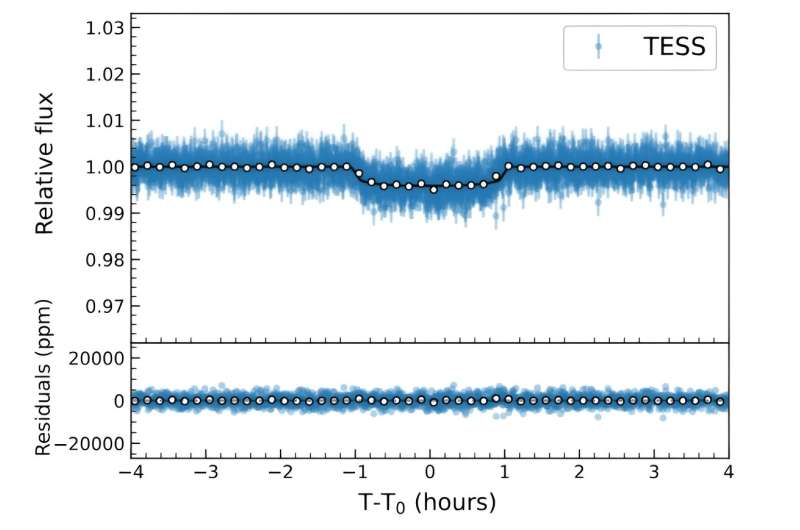March 26, 2024 report
This article has been reviewed according to Science X's editorial process and policies. Editors have highlighted the following attributes while ensuring the content's credibility:
fact-checked
preprint
trusted source
proofread
New nearby mini-Neptune exoplanet discovered

An international team of astronomers reports the discovery of a new mini-Neptune exoplanet orbiting a nearby star. The newfound alien world, designated TOI-4438 b is about 2.5 times larger than the Earth. The finding was detailed in a paper published March 14 on the pre-print server arXiv.
NASA's Transiting Exoplanet Survey Satellite (TESS) has identified more than 7,000 candidate exoplanets (TESS Objects of Interest, or TOI), of which 417 have been confirmed so far. Since its launch in April 2018, the satellite has been conducting a survey of about 200,000 of the brightest stars near the sun with the aim of searching for transiting exoplanets—ranging from small, rocky worlds to gaseous giants.
The so-called mini Neptunes are exoplanets with radii between 1.8 and 4 Earth radii. In general, they are common around M-type dwarf stars and are assumed to host hydrogen-dominated atmospheres.
Now, a group of astronomers led by Elisa Goffo of the University of Turin in Italy has detected a new planet of this type. They report that a transit signal was identified in the light curve of TOI-4438 (or G 182-34)—an M dwarf of spectral type M3.5 V, located some 98 light years away. The planetary nature of this signal was confirmed by follow-up spectroscopic and photometric observations.
"A transit signal was detected with NASA's TESS space mission in the sectors 40, 52, and 53. In order to validate the planet TOI-4438 b and to determine the system properties, we combined TESS data with high-precision radial velocity measurements from the CARMENES spectrograph, spanning almost one year, and ground-based transit photometry," the researchers wrote.
TOI-4438 b has a radius of 2.52 Earth radii, while its mass is approximately 5.4 Earth masses, which yields a bulk density at a level of 1.85 g/cm3. The planet orbits its host every 7.44 days, at a distance of about 0.05 AU from it. The equilibrium temperature of TOI-4438 b is estimated to be 435 K.
Based on the collected data, the astronomers conclude that TOI-4438 b is a volatile-rich mini-Neptune with a relatively high minimum water mass fraction of 46%. They add that the planet very likely has a hydrogen/helium atmosphere, mixed with molecules such as water, carbon dioxide and methane. Given that TOI-4438 b presents a high transmission spectroscopy metric it is among the most suitable targets for atmospheric characterization with the James Webb Space Telescope (JWST).
When it comes to the parent star TOI-4438, it is about one-third the size and mass of the sun. The star is estimated to be 5.1 billion years old, has an effective temperature of some 3,422 K and its metallicity is at a level of approximately -0.19 dex.
More information: E. Goffo et al, TOI-4438 b: a transiting mini-Neptune amenable to atmospheric characterization, arXiv (2024). DOI: 10.48550/arxiv.2403.09833
Journal information: arXiv
© 2024 Science X Network





















